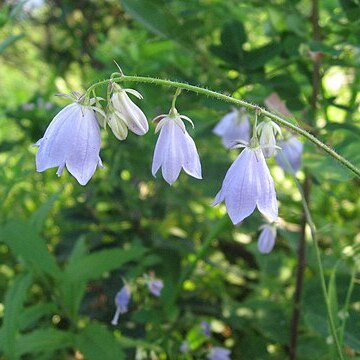Roots 1.5-3.5 cm in diam. Stems single, up to 1 m tall, simple, ± white villous, rarely glabrous. Cauline leaves 3-5-verticillate, sessile; blade rhombic, broadly elliptic, elliptic, elliptic-lanceolate, or lanceolate, 3.5-11 × 1.5-6 cm, both surfaces glabrous or hispidulous along veins, base obtuse or cuneate, margin coarsely serrate, apex obtuse, acute, or acuminate. Inflorescence branches (each with 1 to several cymes) usually verticillate, or sometimes some (rarely all) alternate, forming a large panicle; peduncles of inflorescence branches 2-10 cm; pedicels 0.5-1 cm, glabrous. Hypanthium obconic or obovoid-obconic, glabrous; calyx lobes lanceolate, elliptic-lanceolate, or linear-lanceolate, 5-10 × 1-2.5 mm, margin entire. Corolla blue or light purple, campanulate, 15-22 mm; lobes deltoid-orbicular, 1/3-2/3 as long as tube, both surfaces glabrous. Disk tubular, 1.8-2.5 mm. Style as long as corolla or slightly exserted. Capsule obovoid or broadly ellipsoid, 5-7 × 3-6 mm. Seeds golden brown, ellipsoid, 2-2.5 mm, 1-ribbed. Fl. Jul-Sep, fr. Sep-Oct. 2n = 34.
More
A perennial herb. It grows 1 m tall. The roots can be 2-4 cm across. The leaves on the stem are arranged in rings of 3-5. They are 4-11 cm long by 2-6 cm wide. There are coarse teeth along the edge. The branches on the flowering stalks are in rings. The flowers are blue or pale purple.
It is a temperate plant. It grows best in a light rich slightly alkaline soil. It needs a sunny position. It does not like having its roots disturbed. In north China is grows on grassy slopes and in forests between 400-1,800 m above sea level.
More
Mountains, C. Japan. Deciduous forests and sunny grassy slopes, or on rocks at elevations of 300-1,700 metres.

